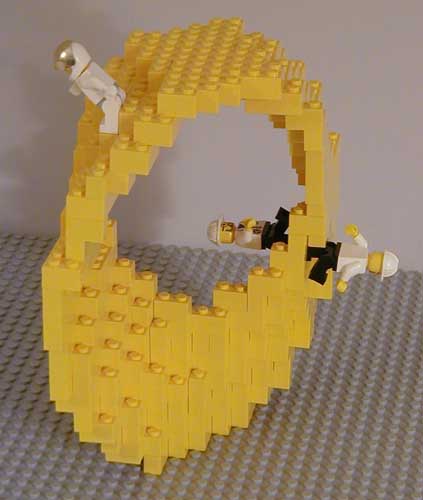
Because The LEGO Company get paranoid about this sort of thing let me make it clear that I have no affiliation with them, that my views are my own and do not necessarily represent theirs, and so on. So if you think any of this is official you are as deluded as they are.

OK, I admit it - these weren't constructed entirely without computer assistance. Usually I write some C code to generate whatever the shape is and figure out which cells in a grid made up of 1x1x1 LEGO bricks should be filled in. The code outputs this as an LDraw .DAT file, separated into construction steps adding one complete layer of the structure in each step. Then I use MLCad to view the .DAT file. I play around with the parameters and repeat until I have something that looks nice and which will probably be able to balance.
But that's the easy part.
Now I have to try to construct it out of actual LEGO bricks so that it actually holds together. Worse, I have to use the collection of bricks actually in my possession and not currently in use in some other construction [in case anyone's interested, I've convinced myself that this is, in general, an NP-hard problem. One of these days I'll write up the proof]. This usually takes far longer than the first stage - and a few times I've had to give up. Occasionally I cheat just a teeny bit and deviate from the output of my code in order to help the structure hold together.
I used to be able to say that all the models shown on this page were constructed using only the 1xN and 2xN standard bricks you can find in the blue bulk tubs. No plates, no L-shapes. That was until I built the Costa surface. I just couldn't make it hold together with bricks alone, so I gave in and used a few small plates too.
And after these, all I can say is... the sooner The LEGO Group starts selling bulk packs of 1x3 bricks the better :-)
When I get round to it, I'll add something here on the actual mathematics. For
the moment, here are some pictures. Marvel at the wasted hours.... Click on the
thumbnails to see more (and larger) pictures
Various sizes of Mobius strip.These were the first mathematical sculptures I attempted. The big one was about my fourth (and I had to cheat a little bit with the top two layers to make it hold together). It's 37 bricks high and balances on a footprint contained in a 5x9 rectangle. It is essentially one brick thick throughout. Click on the thumbnail for more pictures and an LDRAW .DAT file... |
|
A trefoil knot.A friend at work suggested this after seeing the Mobius bands. This was my first
attempt. It is very flimsy (and I cheated in two places by modifying the
collection of occupied cells output by my program). Still, it proved it was
possible.
Click on the thumbnail for more pictures |
|
A figure eight knot.I made this thicker than the trefoil knot in order to help make it rigid. Nonetheless, I think this is the most difficult single construction I have ever made out of LEGO. Those long sweeping curves, hanging unsupported in space... It's only when you get about 2/3 of the way up that you start to discover exactly which bits 1/3 of the way up aren't strong enough. And there are never enough 1x3 bricks... But I didn't cheat anywhere. I'm very pleased with this. The figure-eight knot has a nice tetrahedral skew-symmetry which the model illustrates quite well. Click on the thumbnail for more pictures and an LDRAW .DAT file... |
|
Enneper's minimal surface.The same friend(?) at work (thanks, Fred) said that he thought minimal surfaces would probably be too hard, so.... Click on the thumbnail for more pictures and an LDRAW .DAT file... |
|
And just to prove the point... The Catalan minimal surfaceUntil I made the Klein bottle, this was the largest of all my mathematical LEGO models. Despite the sheets being only one brick thick, the construction is remarkably rigid. I think this probably has to do with the zero curvature of the surface. though I don't really understand what's going on. I am now officially almost out of blue bricks... Click on the thumbnail for more pictures and an LDRAW .DAT file... |
|
A Klein BottleA couple of people asked about a Klein bottle, so here you are. I spent ages finding a nice parametrization of this, so I hope you like it. Click on the thumbnail for more pictures and an LDRAW .DAT file... |
|
A Cross-Cap
|
|
Another Cross-CapI wasn't very happy with the first one, so here's a completely different rendering of the cross-cap in 3-dimensional space. Click on the thumbnail for more pictures and an LDRAW .DAT file... |
|
A Costa SurfaceThis was a bit of a challenge, but I've wanted to do one of these for ages. Click on the thumbnail for more pictures and an LDRAW .DAT file... |
|
Scherk's First SurfaceNot especially challenging, but a nice example of a saddle point Click on the thumbnail for more pictures and an LDRAW .DAT file... |
|
Bour's SurfaceThe most elaborate and difficult yet. It left me with exactly six unused 1x3 yellow pieces. Click on the thumbnail for more pictures and an LDRAW .DAT file... |
|
Boy's SurfaceConstruction was a nightmare and I nearly ran out of 2x4 blue bricks... Click on the thumbnail for more pictures... |
|
Punctured TorusCurrently my favourite. Click on the thumbnail for more pictures... |
The contents of this page are Copyright © A. Lipson 2000-2006
LEGO ® is a trademark of The LEGO Group, who have nothing to do with this or any of my other LEGO-related web pages.
Back to ASL's home page
Back to ASL's LEGO page
 Selected as Cool Math Site of the Week, 9th May 2002 by
Knot a Braid of Links
Selected as Cool Math Site of the Week, 9th May 2002 by
Knot a Braid of Links
 Selected
as Link of the day for 29th May 2002 by userfriendly.org
Selected
as Link of the day for 29th May 2002 by userfriendly.org
Hits since 22nd October 2006:
Powered by
counter.bloke.com
This page last modified 22nd October 2006